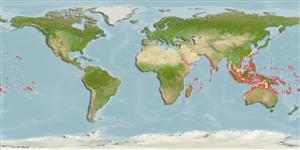Preferred temperature (Ref.
123201): 25 - 29.3, mean 28.3 °C (based on 3362 cells).
Phylogenetic diversity index (Ref.
82804): PD
50 = 0.5005 [Uniqueness, from 0.5 = low to 2.0 = high].
Bayesian length-weight: a=0.00089 (0.00039 - 0.00204), b=3.00 (2.80 - 3.20), in cm total length, based on LWR estimates for this (Sub)family-body shape (Ref.
93245).
ระดับชั้นอาหาร (Ref.
69278): 3.6 ±0.4 se; based on size and trophs of closest relatives
ความสามารถในการกลับคืนสู่ปกติ (Ref.
120179): ขนาดกลาง, เวลาต่ำสุดที่จะทำให้ประชากรเพิ่มขึ้นเป็น 2 เท่าใช้เวลา 1.4 - 4.4 ปี (Preliminary K or Fecundity.).
Fishing Vulnerability (Ref.
59153): High vulnerability (59 of 100).
Nutrients (Ref.
124155): Calcium = 32.9 [18.2, 56.4] mg/100g; Iron = 0.479 [0.290, 0.984] mg/100g; Protein = 18.8 [16.6, 21.4] %; Omega3 = 0.0993 [, ] g/100g; Selenium = 43.9 [25.3, 86.4] μg/100g; VitaminA = 45.9 [13.8, 137.5] μg/100g; Zinc = 0.915 [0.663, 1.266] mg/100g (wet weight);
